- Joined
- Oct 9, 2007
- Messages
- 47,449 (7.50/day)
- Location
- Hyderabad, India
| System Name | RBMK-1000 |
|---|---|
| Processor | AMD Ryzen 7 5700G |
| Motherboard | ASUS ROG Strix B450-E Gaming |
| Cooling | DeepCool Gammax L240 V2 |
| Memory | 2x 8GB G.Skill Sniper X |
| Video Card(s) | Palit GeForce RTX 2080 SUPER GameRock |
| Storage | Western Digital Black NVMe 512GB |
| Display(s) | BenQ 1440p 60 Hz 27-inch |
| Case | Corsair Carbide 100R |
| Audio Device(s) | ASUS SupremeFX S1220A |
| Power Supply | Cooler Master MWE Gold 650W |
| Mouse | ASUS ROG Strix Impact |
| Keyboard | Gamdias Hermes E2 |
| Software | Windows 11 Pro |
Ultrabooks, despite their formidable computing power compared to netbooks, inevitably trade some of it for lower thermal/power specifications. LucidLogix feels that Ultrabook users could gain graphics processing power on demand using external graphics cards, that work in tandem with its VirtuMVP GPU virtualization technology. At IDF, the company demonstrated an external graphics card that uses 10 Gb/s Thunderbolt interface to communicate with an Ultrabook.
Lucid's external graphics card is a Thunderbolt to PCI-Express enclosure, which runs an AMD Radeon HD 6700 series GPU. With the VirtuMVP layer running, the Ultrabook uses the graphics computing power of the external graphics card to render complex graphics onto its display, which is wired to the processor's integrated graphics core. Lucid's idea of on-demand graphics compute power allows Thunderbolt-equipped Ultrabooks of all shapes and sizes to lack a discrete GPU, which adds to the device's cost, and taps its limited power and thermal-control resources. At the moment, Lucid's external graphics cards are still in development, with no concrete release date in sight. The concept is solid.

View at TechPowerUp Main Site
Lucid's external graphics card is a Thunderbolt to PCI-Express enclosure, which runs an AMD Radeon HD 6700 series GPU. With the VirtuMVP layer running, the Ultrabook uses the graphics computing power of the external graphics card to render complex graphics onto its display, which is wired to the processor's integrated graphics core. Lucid's idea of on-demand graphics compute power allows Thunderbolt-equipped Ultrabooks of all shapes and sizes to lack a discrete GPU, which adds to the device's cost, and taps its limited power and thermal-control resources. At the moment, Lucid's external graphics cards are still in development, with no concrete release date in sight. The concept is solid.

View at TechPowerUp Main Site










